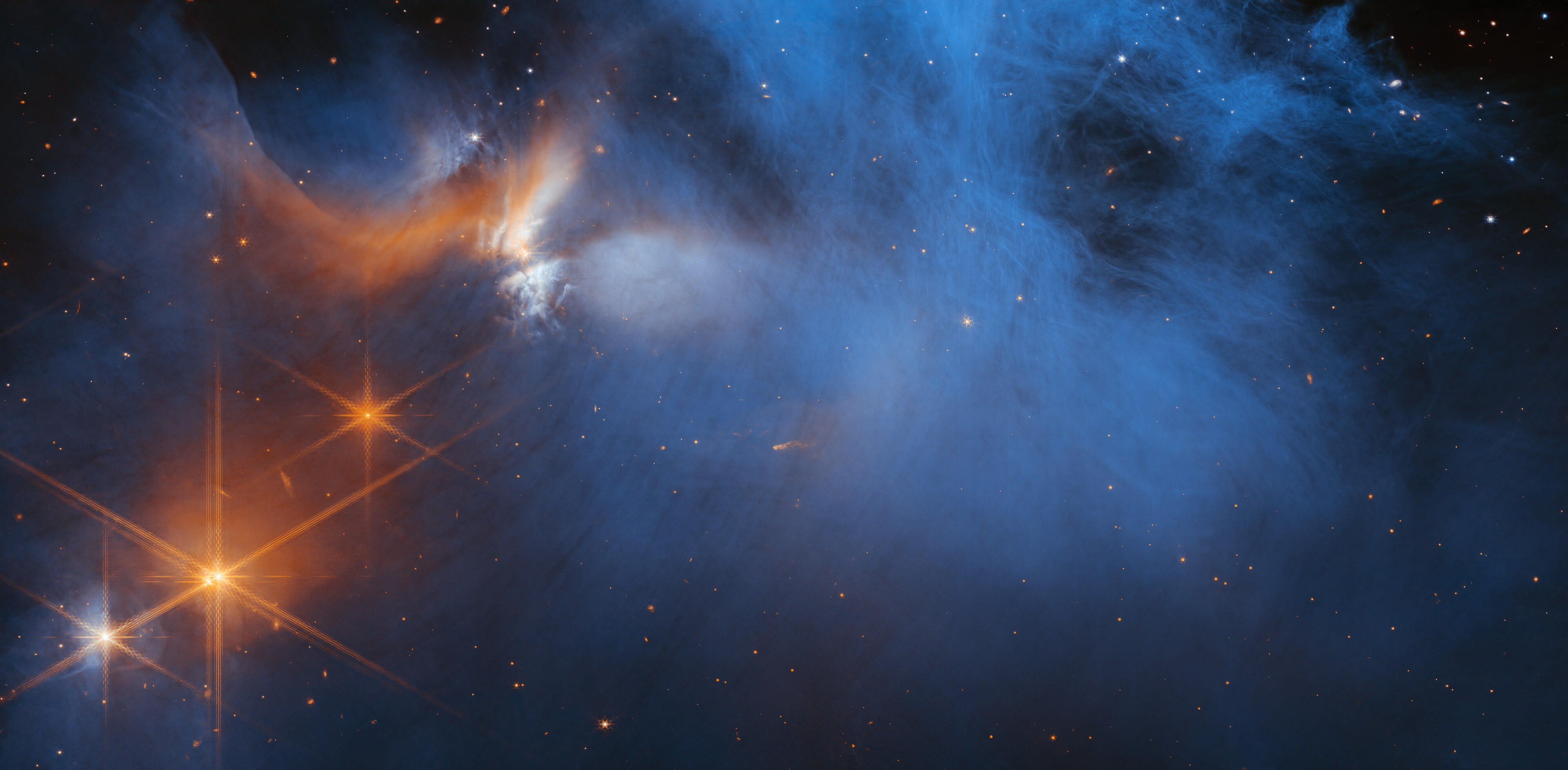James Webb Space Telescope identifies origins of icy building blocks of life
Interstellar molecular clouds are considered to be the birth sites of planetary systems. With the help of the James Webb Space Telescope, an international research team including the Center for Space and Habitability (CSH) at the University of Bern and the National Centre of Competence in Research (NCCR) PlanetS discovered the deepest and coldest ice ever detected in such a molecular cloud. The discovery provides astronomers with new insights into the icy components that could be incorporated into planets over time and eventually form the basis for life.
Frozen molecules were central to the origin of life on Earth. In addition to impacts of icy comets and asteroids, according to current theory, our planet likely also received the elementary components of life from the ices of the immense interstellar molecular cloud from which the Earth and the rest of the solar system emerged. In a new study, an international research team, with the participation of a researcher from the University of Bern and the National Centre of Competence in Research (NCCR) PlanetS, has now discovered ice in deeper regions of such a molecular cloud than ever before. At the same time, with a temperature of about minus 263 degrees Celsius (or about ten degrees above absolute zero), it is the coldest ice ever measured. The results were published in the journal Nature Astronomy.
A wealth of ice varieties
"This is the first time researchers have been able to study the composition of so-called pre-stellar ices near the centre of a molecular cloud," says Melissa McClure, an astronomer at Leiden Observatory and lead author of the study. "In addition to simple ices such as water, carbon dioxide, carbon monoxide, ammonia, and methane we were able to identify several other compounds, including the more complex organic ice methanol." The measurements, made by the team with the JWST of NASA, ESA and the Canadian Space Agency (CSA), provide the research community with unprecedented insights into the abundance of icy compounds that can be found inside interstellar molecular clouds – and subsequently incorporated into stars and planets that emerge from them.
A necessary precision
"We recognise the different icy molecules by their so-called absorption spectrum. They leave this chemical fingerprint against the background starlight that shines through the cloud onto the telescope," explains study co-author and researcher at the NCCR PlanetS and the University of Bern, Maria Drozdovskaya. She is part of the Ice Age team, which consists of 50 experts in astrochemistry, laboratory astrophysics, star formation and the interstellar medium from 10 countries (see also info box).
In this study, the team focused on the molecular cloud "Chameleon I", more than 500 light years away from Earth, in which dozens of young stars are currently forming. They are located near the centre, in a particularly cold, dense and therefore difficult to study region. "Only with the Webb's high-precision infrared spectrographs (NIRSpec and MIRI), which can precisely detect and resolve radiation at these wavelengths, were these measurements possible," says the astronomer.
Do planets contain the ingredients of life from the beginning?
But the measurements not only provided the research team with unprecedented insights, they also provided them with new puzzles. "We were able to measure not only the occurrence of these substances, but also the abundance of some elements contained in the icy compounds," explains Drozdovskaya. These elements are carbon, hydrogen, oxygen, nitrogen and sulphur, which the team collectively refers to as CHONS. "These elements are important components of prebiotic molecules such as simple amino acids - and thus ingredients of life, so to speak," Drozdovskaya says. But the team found that the amount of these elements in the measured ices was less than the total budget of each element expected, based on the density of this cloud. This suggests that these elements are not found exclusively in the icy components of molecular clouds, but could also be lurking elsewhere.
"The fact that we are 'missing' some of the CHONS budget could mean that CHONS are trapped in rocky dust particles, for example," explains Melissa McClure. "This could allow a greater diversity in the bulk composition of terrestrial planets." The team's identification of complex organic molecules, like methanol and potentially ethanol, also suggests that the many star and planet systems developing in this particular cloud will inherit molecules from the molecular cloud in a fairly advanced chemical state. "This could mean that the presence of prebiotic molecules in planetary systems is a common result of star formation, rather than a unique feature of our own Solar System", says McClure.
Publication details:M. K. McClure, W. R. M. Rocha, K. M. Pontoppidan, N. Crouzet, L. E. U. Chu, E. Dartois, T. Lamberts, J. A. Noble, Y. J. Pendleton, G. Perotti, D. Qasim, M. G. Rachid, Z. L. Smith, F. Sun, Tracy L. Beck, A. C. A. Boogert, W. A. Brown, P. Caselli, S. B. Charnley, Herma M. Cuppen, H. Dickinson, M. N. Drozdovskaya, E. Egami, J. Erkal, H. Fraser, R. T. Garrod, D. Harsono, S. Ioppolo, I. Jiménez-Serra2, M. Jin, J. K. Jørgensen, L. E. Kristensen, D. C. Lis, M. R. S. McCoustra, Brett A. McGuire, G. J. Melnick, Karin I. Öberg, M. E. Palumbo, T. Shimonishi, J. A. Sturm, E. F. van Dishoeck & H. Linnartz, An Ice Age JWST inventory of dense molecular cloud ices , Nature Astronomy, January 2023 DOI: 10.1038/s41550-022-01875-w |
Early Release Science James-Webb-Space TelescopeThe James Webb Space telescope (JWST), also known as "Webb", is the largest, most powerful telescope ever launched into space. Webb follows Hubble as the next great space science observatory designed to make breakthrough discoveries in all fields of astronomy. It will push the frontiers of knowledge of our Solar System, reveal the Universe's first galaxies and the birth of stars and planets, and look for exoplanets with the potential for life. Webb is a collaboration between the North American (NASA), European (ESA) and Canadian (CSA) Space Agencies. Switzerland is part of the nationally funded European Consortium, which, together with the USA, has developed one of the four science instruments on JWST: the The Mid Infrared Instrument (MIRI). The Ice Age project is one of Webb's 13 "Early Release Science'' programs. These observations are designed to showcase Webb’s observing capabilities and allow the astronomical community to learn how to get the best from its instruments. |
Bernese space exploration: With the world’s elite since the first moon landingWhen the second man, "Buzz" Aldrin, stepped out of the lunar module on July 21, 1969, the first task he did was to set up the Bernese Solar Wind Composition experiment (SWC) also known as the “solar wind sail” by planting it in the ground of the moon, even before the American flag. This experiment, which was planned, built and the results analyzed by Prof. Dr. Johannes Geiss and his team from the Physics Institute of the University of Bern, was the first great highlight in the history of Bernese space exploration. Ever since Bernese space exploration has been among the world’s elite, and the University of Bern has been participating in space missions of the major space organizations, such as ESA, NASA, and JAXA. With CHEOPS the University of Bern shares responsibility with ESA for a whole mission. In addition, Bernese researchers are among the world leaders when it comes to models and simulations of the formation and development of planets. The successful work of the Department of Space Research and Planetary Sciences (WP) from the Physics Institute of the University of Bern was consolidated by the foundation of a university competence center, the Center for Space and Habitability (CSH). The Swiss National Fund also awarded the University of Bern the National Center of Competence in Research (NCCR) PlanetS, which it manages together with the University of Geneva. |
2023/01/23



